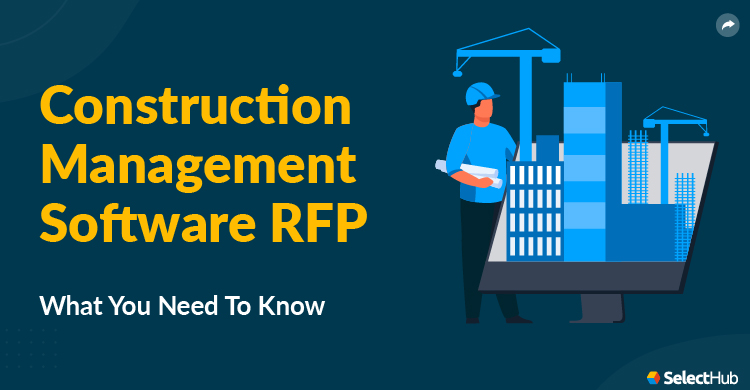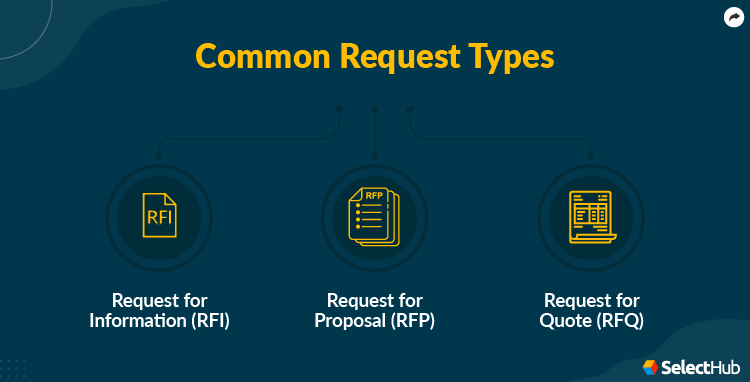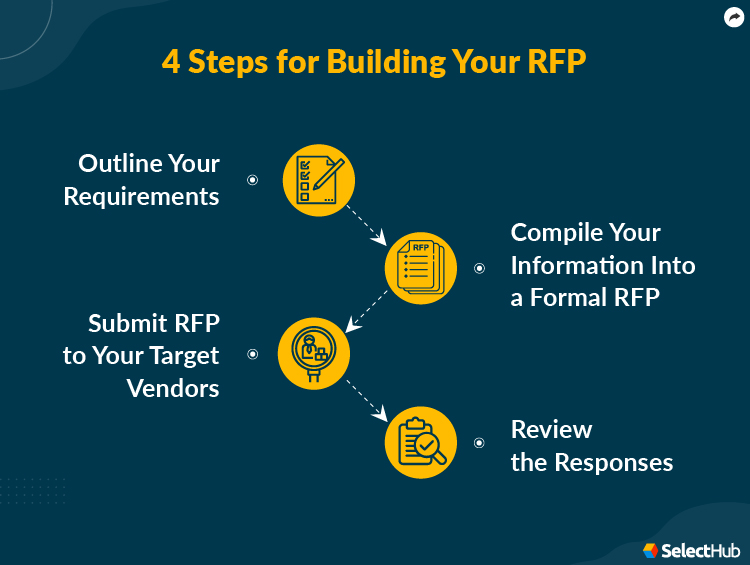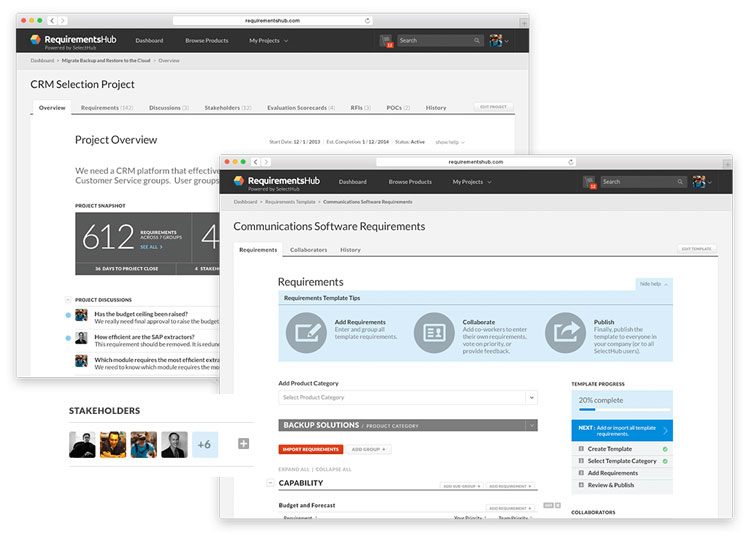You’re on the hunt for construction management software. Congrats! One of the steps you’ll want to nail is sending a construction management software RFP to vendors for an idea of their platforms and services. The goal of this article is to help you do just that.
Get our Construction Management Requirements Template

As technology becomes more embedded in the core of how construction companies operate, you need to make sure your selection process is on point. After all, investing in software can come with a hefty price tag. It’s best to find a good fit on your first try.
That means you need to do a lot of research to know what software’s on the market and how it will benefit your business.
One of the cornerstones of that research process? Sending a request for proposal (RFP). A well-written construction management software RFP will go a long way in aiding your search and ensuring you end up with a solution you can implement successfully.
With that in mind, off we go!
What This Guide Covers:
What’s an RFP?
The concept behind a request for proposal is pretty straightforward. You — wait for it — send out requests asking for proposals.
But, did you know there are some other common requests you can make during your hunt for construction software that may be beneficial too?

Here’s a quick overview of the top three requests and how they differ.
Request for Information
A construction RFI can be a sticky subject. Unlike some industries, construction uses RFIs during more than the initial phase.
In a perfect world, everything would always go according to plan. Problem is, that usually doesn’t happen. Because of that, RFIs have become a go-to during every stage of the construction process. They help:
- Solve conflicts
- Clarify questions that arise
- Overcome gaps that didn’t get covered at the outset of a project
- Request changes to things like drawings
For this article, we’re going to focus on RFIs in the context of gathering information to help you draft a detailed construction management software RFP.
This process is the starting point of your search for your new software. When used for that purpose, it’s the broadest of the three major requests you may make during your selection process.
If you need to gather a lot of information due to a lack of experience or familiarity with the industry, this is where you begin. To get the best idea of what’s out there, contact a variety of vendors so you can see the range of what’s on the market. Send off a request that includes:
- General details about your company
- An overview of the challenges you’re looking to solve
- The query date
- A response deadline
In response, construction management software vendors will typically send you a broad description of what they offer and how their software can help you. From there, it’s time to whittle down your choices and begin the construction management RFP process.
Request for Proposal
You’ve sent out enough RFIs to create a shortlist of vendors. Now it’s time for the RFP to step in and do the heavy lifting of narrowing that list even further.
When you send out a construction management software RFP, make sure to get specific. List the challenges you want to overcome and the goals you hope to achieve.
With those details laid out, vendors can know exactly what you need help with and how they can fill that need. They’ll respond with a detailed plan of their own, outlining ways their product will solve your problems and help you reach your goals.
Request for Quote
The third request you can send is a request for quote (RFQ), also called a request for quotation. Compared to the other two, RFQ is the most narrow in scope. If your search process is a three-rung ladder leading you up to the perfect construction management software, RFQ is the top rung.
At this point, you’ll have your preliminary research out of the way and will be looking for details.
As the name implies, this is the stage where the vendors you contact will submit specific quotes. Besides that, they’ll often include tangibles as opposed to the intangibles covered in an RFI or RFP.
Your RFI and RFP focused on concepts — problems, goals and so on. With the RFQ, the focus shifts to the nitty-gritty details such as the number of users supported, deployment method, cost, implementation process and so forth.
Automate RFI/RFP Creation with the Decision Platform
4 Steps for Building Your RFP
While RFIs and RFQs are valuable, your RFP is the most critical aspect of choosing the best software, which makes getting it right a top priority.

That begs the question, how do you build a fantastic RFP for construction management software? Let’s examine each of the four steps involved.
1. Outline Your Requirements
First up, you need to build a list of requirements based on your organization’s needs.

RequirementsHub provides the tools to begin building your construction management software RFP and sharing it with stakeholders.
For the best result, be sure to encourage open communication across departments and get the input of key stakeholders and users. It’s easy for each department to only consider what they need out of a solution and not take other factors into account.
For example, your IT department will care about the technical aspects of a system, while a project manager’s eye would be on the features and functionalities that will make their day-to-day jobs easier. By including everyone during this phase, you can be confident you won’t miss any critical details.
You’ll want a system that’s comprehensive but not over the top. Knowing your criteria helps with that and will provide you with the Goldilocks of software — not too much and not too little, but just right.
For construction management, the must-haves could include:
- Document management features that improve company-wide organization and create a single source of truth for projects
- AI and machine learning capabilities to help you make sense of all your data
- Cloud deployment, streamlining communication and giving your workers access to data while out in the field
- Open APIs so the system can interface with other software you use
Those are some examples, but keep in mind that no third-party list will be perfect. Only the people who work at your company will know every detail of your must-haves compared to what you can get away without. That should always be your top consideration.
2. Compile Your Information Into a Formal RFP
Once you have a specific list of requirements, you can compile that information into your construction RFP.
And yes, it needs to be formal — professional, organized and well-designed. You want construction software vendors to take you seriously. You expect vendors to make a good impression, so you shouldn’t demand any less of your business.
Besides the requirements you identified, include information about your company. The more details you share about your operations, target customers, industry positioning and so forth, the easier it will be for vendors to understand your business and propose the specific ways they can help you.
Don’t forget to include technical information as well. For example, the vendor will need to know if you’re upgrading from a legacy system to a cloud-based construction management solution. If no one on your team or at your company has the necessary expertise to build this part of your RFP, don’t worry. Plenty of third-party services can manage that piece for you.
Finally, you may want to use an RFP program to submit and manage your requests, such as SelectHub’s software selection platform that guides you through requirements gathering to vendor shortlists and RFP processes. If you have a shortlist longer than a handful of vendors, this will save you loads of time. The program will automatically compile and analyze each proposal you receive.
3. Submit RFP to Your Target Vendors
You’ve done the legwork of putting your construction management RFP together. Now it’s time to get the ball rolling.
If you used an RFI, you should have a tidy list of software vendors you want to target. If not, now’s the time to start narrowing your search. It’ll take longer, but the extra time will be worth the effort.
You don’t want to send out dozens of poorly-targeted RFPs. At best, you’ll only get a few responses, and at worst, you’ll sort through a bunch of construction solutions vendors whose software won’t end up serving your needs. Plus, you’ll add to your workload since vetting even half-a-dozen vendors will take time.
Better to do the additional research ahead of time and know that your RFPs will target precisely the vendors you want to reach so you can thoroughly analyze what they offer.
Once again, a software program designed to handle the RFP process will be your friend. You can opt for email, but a tool specifically made to manage your RFPs will make the process more efficient. Vendors will be able to respond more easily, and you’ll be able to keep track of everything in a central place instead of chasing email threads through your already cluttered inbox.
Our construction management RFP template is a great starting point. You can customize it based on your top requirements, gain stakeholder validation and review vendor responses. Getting RFP responses takes a lot of time, but having a program on your side will alleviate some of that burden and let you focus on your daily responsibilities.

View potential vendors and invite team feedback with SelectHub’s collaborative platform.
Finally, keep in mind that proposals don’t exist in the same world as Amazon’s two-day shipping. Vendors will take at least a few weeks to put together quality responses. That means you need to be patient — and plan ahead so you’re not demanding a rushed deadline when you send your RFPs out.
4. Review the Responses
The vendor proposals are coming in. Great! Now what?
It’s time to review each proposal and see how each vendor responds to your particular requirements and questions. Their responses will provide insight into the software aspects that matter to you, giving you a comprehensive look at how each vendor stacks up against the rest and how their product can fulfill your expectations — or not.
As you examine proposals, look for indications that a company performed due diligence and is worth considering. They should have answers to any specific questions you asked, or else request clarification. Also, look for unique qualities they list that will help your business succeed, other clients they’ve helped who are similar to you, general company info and pricing.
Make sure to take notice of their tone and approach. Does their proposal sound like a canned response they could have sent to any company? If so, move on. Even if a proposal follows a set pattern, it should include personalized information that specifically addresses your RFP’s details.
What about answering proposals? For that, you have two choices:
- Wait until you’ve received every proposal, and then respond to them all
- Respond to each proposal as it comes in
Ideally, you’re better off replying during the process. Waiting until you have all the proposals can delay your selection. If vendors have follow-up questions for you, answering them right away will keep the process moving.
Automate RFI/RFP Creation with the Decision Platform
Evaluate Your Responses
This is the point you’ve been heading toward. After you tabulate all the vendor responses, it’s time to sort through them. One may emerge as the clear choice for your construction management software. If not, pick three to four of the top vendors that most successfully ticked your requirements boxes and conduct some follow-up.
- Get demos (if you haven’t already done that)
- Ask for a proof of concept presentation, which shows how the software will perform a specific task
These are valuable steps since they let you see the solution in action. Reading about features and looking at reviews is great, but nothing beats seeing the software working as it would at your company. This strategy will help you spot any potential problem areas or see places where the capabilities are more powerful than you realized. Getting that real-world look at each system will enable you to make an informed decision.

Review your RFP with vendors, request demos and discuss pricing.
If the demo and proof of concept don’t produce a choice, shift the focus to price. No matter how perfect a system may be, you still need it to fit inside your budget. The cost is an important factor and may end up helping you ultimately determine which vendor to select.
You can only choose one “winner,” so be courteous to all the vendors by keeping them updated on their status. If you’ve eliminated them from your list, let them know.
Once you choose the vendor you want to partner with, you’ll go through the final steps of negotiating and finalizing the contract. At this stage, talk to the vendor about implementation. Many vendors offer services to help facilitate a smooth rollout. Along with support, they may also provide training. Find out how your vendor handles support so you don’t run into unexpected issues during implementation.
Final Thoughts
Selecting software for construction management isn’t a simple matter of calling up a few vendors or doing a quick Google search before settling on the right solution. It takes patience, time and enough research to fill a dump truck.
By following this construction management software RFP guide, you’ll be well on your way to ensuring that you get the right solution for the right price.
If you’re early on in your journey, our free comparison report can help you identify the top vendors in the industry. If you want deeper insight into specific vendors or a quick-start guide to help you decide which ones to include on your RFP shortlist, this is a perfect starting point.
What questions do you have about the construction management RFP process for evaluating new software? Give us a holler in the comments below!

Leave a Reply